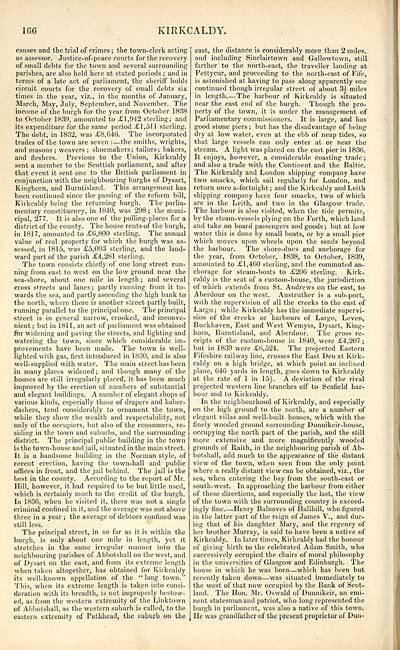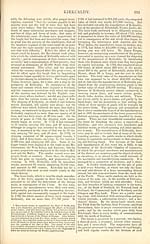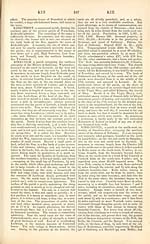Topographical, statistical, and historical gazetteer of Scotland > Volume 2
(178) Page 166
Download files
Complete book:
Individual page:
Thumbnail gallery: Grid view | List view

166
KIRKCALDY.
causes and the trial of crimes ; the town-clerk acting
as assessor. Justice-of-peace courts for the recovery
of small debts for the town and several surrounding
parishes, are also held here at stated periods ; and in
terms of a late act of parliament, the sheriff holds
circuit courts for the recovery of small debts six
times in the year, viz., in the months of January,
March, May, July, September, and November. The
income of the burgh for the year from October 1838
to October 1839, amounted to £1,942 sterling; and
its expenditure for the same period £1,511 sterling.
The debt, in 1832, was £8,646. The incorporated
trades of the town are seven : — the smiths, wrights,
and masons ; weavers ; shoemakers; tailors; bakers,
and fleshers. Previous to the Union, Kirkcaldy
sent a member to the Scottish parliament, and after
that event it sent one to the British parliament in
conjunction with the neighbouring burghs of Dysart,
Kinghorn, and Burntisland. This arrangement has
been continued since the passing of the reform bill,
Kirkcaldy being the returning burgh. The parlia-
mentary constituency, in 1840, was 298; the muni-
cipal, 277. It is also one of the polling-places for a
district of the county. The bouse rents of the burgh,
in 1817, amounted to £6,800 sterling. The annual
value of real property for which the burgh was as-
sessed, in 1815, was £5,093 sterling, and the land-
ward part of the parish £4,281 sterling.
The town consists chiefly of one long street run-
ning from east to west on the low ground near the
sea-shore, about one mile in length; and several
cross streets and lanes ; partly running from it to-
wards the sea, and partly ascending the high bank to
the north, where there is another street partly built,
running parallel to the principal one. The principal
street is in general narrow, crooked, and inconve-
nient ; but in 181 1, an act of parliament was obtained
fbr widening and paving the streets, and lighting and
watering the town, since which considerable im-
provements have been made. The town is well-
lighted with gas, first introduced in 1830, and is also
well-supplied with water. The main street has been
in many places widened ; and though many of the
houses are still irregularly placed, it has been much
improved by the erection of numbers of substantial
and elegant buildings. A number of elegant shops of
various kinds, especially those of drapers and haber-
dashers, tend considerably to ornament the town,
while they show the wealth and respectability, not
only of the occupiers, but also of the consumers, re-
siding in the town and suburbs, and the surrounding
district. The principal public building in the town
is the town-house and jail, situated in the main street.
It is a handsome building in the Norman style, of
recent erection, having the town-hall and public
offices in front, and the jail behind. The jail is the
best in the county. According to the report of Mr.
Hill, however, it had required to be but little used,
which is certainly much to the credit of the burgh.
In 1836, when he visited it, there was not a single
criminal confined in it, and the average was not above
three in a year ; the average of debtors confined was
still less.
The principal street, in so far as it is within the
burgh, is only about one mile in length, yet it
stretches in the same irregular manner into the
neighbouring parishes of Abbotshall on the west, and
of Dysart on the east, and from its extreme length
when taken altogether, has obtained for Kirkcaldy
its well-known appellation of the " lang town."
This, when its extreme length is taken into consi-
deration with its breadth, is not improperly bestow-
ed, as from the western extremity of the Linktown
of Abbotshall, as the western suburb is called, to the
eastern extremity of Pathheud, the suburb on the
east, the distance is considerably more than 2 miles,
and including Sinclairtown and Gallowtown, still
farther to the north-east, the traveller landing at
Pettycur, and proceeding to the north-east of Fife,
is astonished at having to pass along apparently one
continued though irregular street of about 3i miles
in length The harbour of Kirkcaldy is situated
near the east end of the burgh. Though the pro-
perty of the town, it is under the management of
Parliamentary commissioners. It is large, and has
good stone piers ; but has the disadvantage of being
dry at low water, even at the ebb of neap tides, so
that large vessels can only enter at or near the
stream. A light was placed on the east pier in 1836.
It enjoys, however, a considerable coasting trade ;
and also a trade with the Continent and the Baltic.
The Kirkcaldy and London shipping company have
two smacks, which sail regularly for London, and
return once a-fortnight ; and the Kirkcaldy and Leith
shipping company have four smacks, two of which
are in the Leith, and two in the Glasgow trade.
The harbour is also visited, when the tide permits,
by the steam-vessels plying on the Forth, which land
and take on board passengers and goods ; but at low
water this is done by small boats, or by a small pier
which moves upon wheels upon the sands beyond
the harbour. The shore-dues and anchorage for
the year, from October, 1838, to October, 1839,
amounted to £1,460 sterling, and the commuted an-
chorage for steam-boats to £206 sterling. Kirk-
caldy is the seat of a custom-house, the jurisdiction
of which extends from St. Andrews on the east, to
Aberdour on the west. Anstruther is a sub-port,
with the supervision of all the creeks to the east of
Largo; while Kirkcaldy has the immediate supervi-
sion of the creeks or harbours of Largo, Leven,
Buckhaven, East and West Wemyss, Dysart, King-
horn, Burntisland, and Aberdour. The gross re-
ceipts of the custom-house in 1840, were £4,207 ;
but in 1839 were £6,524. The projected Eastern
Fifeshire railway line, crosses the East Den at Kirk-
caldy on a high bridge, at which point an inclined
plane, 646 yards in length, goes down to Kirkcaldy
at the rate of 1 in 15^. A deviation of the rival
projected western line branches off to Seafield har-
bour and to Kirkcaldy.
In the neighbourhood of Kirkcaldy, and especially
on the high ground to the north, are a number of
elegant villas and well-built houses, which with the
finely wooded ground surrounding Dunnikeir-house,
occupying the north part of the parish, and the still
more extensive and more magnificently wooded
grounds of Raith, in the neighbouring parish of Ab-
botshall, add much to the appearance of the distant
view of the town, when seen from the only point
where a really distant view can be obtained, viz., the
sea, when entering the bay from the south-east or
south-west. In approaching the harbour from either
of these directions, and especially the last, the view
of the town with the surrounding country is exceed-
ingly fine Henry Balnaves of flallhill, who figured
in the latter part of the reign of James V., and dur-
ing that of his daughter Mary, and the regency of
her brother Murray, is said to have been a native of
Kirkcaldy. In later times, Kirkcaldy had the honour
of giving birth to the celebrated Adam Smith, who
successively occupied the chairs of moral philosophy
in the universities of Glasgow and Edinburgh. The
house in which he was born — which has been but
recently taken down — was situated immediately to
the west of that now occupied by the Bank of Scot-
land. The Hon. Mr. Oswald of Dunnikeir, an emi-
nent statesman and patriot, who long represented the
burgh in parliament, was also a native of this town.
He was grandfather of the present proprietor of Dun-
KIRKCALDY.
causes and the trial of crimes ; the town-clerk acting
as assessor. Justice-of-peace courts for the recovery
of small debts for the town and several surrounding
parishes, are also held here at stated periods ; and in
terms of a late act of parliament, the sheriff holds
circuit courts for the recovery of small debts six
times in the year, viz., in the months of January,
March, May, July, September, and November. The
income of the burgh for the year from October 1838
to October 1839, amounted to £1,942 sterling; and
its expenditure for the same period £1,511 sterling.
The debt, in 1832, was £8,646. The incorporated
trades of the town are seven : — the smiths, wrights,
and masons ; weavers ; shoemakers; tailors; bakers,
and fleshers. Previous to the Union, Kirkcaldy
sent a member to the Scottish parliament, and after
that event it sent one to the British parliament in
conjunction with the neighbouring burghs of Dysart,
Kinghorn, and Burntisland. This arrangement has
been continued since the passing of the reform bill,
Kirkcaldy being the returning burgh. The parlia-
mentary constituency, in 1840, was 298; the muni-
cipal, 277. It is also one of the polling-places for a
district of the county. The bouse rents of the burgh,
in 1817, amounted to £6,800 sterling. The annual
value of real property for which the burgh was as-
sessed, in 1815, was £5,093 sterling, and the land-
ward part of the parish £4,281 sterling.
The town consists chiefly of one long street run-
ning from east to west on the low ground near the
sea-shore, about one mile in length; and several
cross streets and lanes ; partly running from it to-
wards the sea, and partly ascending the high bank to
the north, where there is another street partly built,
running parallel to the principal one. The principal
street is in general narrow, crooked, and inconve-
nient ; but in 181 1, an act of parliament was obtained
fbr widening and paving the streets, and lighting and
watering the town, since which considerable im-
provements have been made. The town is well-
lighted with gas, first introduced in 1830, and is also
well-supplied with water. The main street has been
in many places widened ; and though many of the
houses are still irregularly placed, it has been much
improved by the erection of numbers of substantial
and elegant buildings. A number of elegant shops of
various kinds, especially those of drapers and haber-
dashers, tend considerably to ornament the town,
while they show the wealth and respectability, not
only of the occupiers, but also of the consumers, re-
siding in the town and suburbs, and the surrounding
district. The principal public building in the town
is the town-house and jail, situated in the main street.
It is a handsome building in the Norman style, of
recent erection, having the town-hall and public
offices in front, and the jail behind. The jail is the
best in the county. According to the report of Mr.
Hill, however, it had required to be but little used,
which is certainly much to the credit of the burgh.
In 1836, when he visited it, there was not a single
criminal confined in it, and the average was not above
three in a year ; the average of debtors confined was
still less.
The principal street, in so far as it is within the
burgh, is only about one mile in length, yet it
stretches in the same irregular manner into the
neighbouring parishes of Abbotshall on the west, and
of Dysart on the east, and from its extreme length
when taken altogether, has obtained for Kirkcaldy
its well-known appellation of the " lang town."
This, when its extreme length is taken into consi-
deration with its breadth, is not improperly bestow-
ed, as from the western extremity of the Linktown
of Abbotshall, as the western suburb is called, to the
eastern extremity of Pathheud, the suburb on the
east, the distance is considerably more than 2 miles,
and including Sinclairtown and Gallowtown, still
farther to the north-east, the traveller landing at
Pettycur, and proceeding to the north-east of Fife,
is astonished at having to pass along apparently one
continued though irregular street of about 3i miles
in length The harbour of Kirkcaldy is situated
near the east end of the burgh. Though the pro-
perty of the town, it is under the management of
Parliamentary commissioners. It is large, and has
good stone piers ; but has the disadvantage of being
dry at low water, even at the ebb of neap tides, so
that large vessels can only enter at or near the
stream. A light was placed on the east pier in 1836.
It enjoys, however, a considerable coasting trade ;
and also a trade with the Continent and the Baltic.
The Kirkcaldy and London shipping company have
two smacks, which sail regularly for London, and
return once a-fortnight ; and the Kirkcaldy and Leith
shipping company have four smacks, two of which
are in the Leith, and two in the Glasgow trade.
The harbour is also visited, when the tide permits,
by the steam-vessels plying on the Forth, which land
and take on board passengers and goods ; but at low
water this is done by small boats, or by a small pier
which moves upon wheels upon the sands beyond
the harbour. The shore-dues and anchorage for
the year, from October, 1838, to October, 1839,
amounted to £1,460 sterling, and the commuted an-
chorage for steam-boats to £206 sterling. Kirk-
caldy is the seat of a custom-house, the jurisdiction
of which extends from St. Andrews on the east, to
Aberdour on the west. Anstruther is a sub-port,
with the supervision of all the creeks to the east of
Largo; while Kirkcaldy has the immediate supervi-
sion of the creeks or harbours of Largo, Leven,
Buckhaven, East and West Wemyss, Dysart, King-
horn, Burntisland, and Aberdour. The gross re-
ceipts of the custom-house in 1840, were £4,207 ;
but in 1839 were £6,524. The projected Eastern
Fifeshire railway line, crosses the East Den at Kirk-
caldy on a high bridge, at which point an inclined
plane, 646 yards in length, goes down to Kirkcaldy
at the rate of 1 in 15^. A deviation of the rival
projected western line branches off to Seafield har-
bour and to Kirkcaldy.
In the neighbourhood of Kirkcaldy, and especially
on the high ground to the north, are a number of
elegant villas and well-built houses, which with the
finely wooded ground surrounding Dunnikeir-house,
occupying the north part of the parish, and the still
more extensive and more magnificently wooded
grounds of Raith, in the neighbouring parish of Ab-
botshall, add much to the appearance of the distant
view of the town, when seen from the only point
where a really distant view can be obtained, viz., the
sea, when entering the bay from the south-east or
south-west. In approaching the harbour from either
of these directions, and especially the last, the view
of the town with the surrounding country is exceed-
ingly fine Henry Balnaves of flallhill, who figured
in the latter part of the reign of James V., and dur-
ing that of his daughter Mary, and the regency of
her brother Murray, is said to have been a native of
Kirkcaldy. In later times, Kirkcaldy had the honour
of giving birth to the celebrated Adam Smith, who
successively occupied the chairs of moral philosophy
in the universities of Glasgow and Edinburgh. The
house in which he was born — which has been but
recently taken down — was situated immediately to
the west of that now occupied by the Bank of Scot-
land. The Hon. Mr. Oswald of Dunnikeir, an emi-
nent statesman and patriot, who long represented the
burgh in parliament, was also a native of this town.
He was grandfather of the present proprietor of Dun-
Set display mode to: Large image | Transcription
Images and transcriptions on this page, including medium image downloads, may be used under the Creative Commons Attribution 4.0 International Licence unless otherwise stated. ![]()
| Gazetteers of Scotland, 1803-1901 > Topographical, statistical, and historical gazetteer of Scotland > Volume 2 > (178) Page 166 |
|---|
| Permanent URL | https://digital.nls.uk/97450726 |
|---|
| Description | Volume second: I-Z. |
|---|---|
| Shelfmark | Map Room Ref.2 |
| Attribution and copyright: |
|

